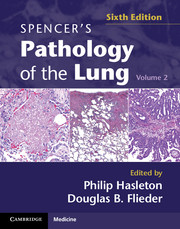Book contents
- Frontmatter
- Dedication
- Contents
- Contents
- Contributors
- Foreword to the First Edition
- Preface to the Sixth Edition
- Acknowledgements
- Chapter 1 The normal lung: histology, embryology, development, aging and function
- Chapter 2 Lung specimen handling and practical considerations
- Chapter 3 Congenital abnormalities and pediatric lung diseases, including neoplasms
- Chapter 4 Pulmonary bacterial infections
- Chapter 5 Pulmonary viral infections
- Chapter 6 Pulmonary mycobacterial infections
- Chapter 7 Pulmonary mycotic infections
- Chapter 8 Pulmonary parasitic infections
- Chapter 9 Acute lung injury
- Chapter 10 Interstitial lung diseases
- Chapter 11 Metabolic and inherited connective tissue disorders involving the lung
- Chapter 12 Hypersensitivity pneumonitis
- Chapter 13 Sarcoidosis
- Chapter 14 Occupational lung disease
- Chapter 15 Eosinophilic lung disease
- Chapter 16 Drug- and therapy-induced lung injury
- Chapter 17 Chronic obstructive pulmonary disease and diseases of the airways
- Chapter 18 Pulmonary vascular pathology
- Chapter 19 Pulmonary vasculitis and pulmonary hemorrhage syndromes
- Chapter 20 The pathology of lung transplantation
- Chapter 21 The lungs in connective tissue disease
- Chapter 22 Benign epithelial neoplasms and tumor-like proliferations of the lung
- Chapter 23 Pulmonary pre-invasive disease
- Chapter 24 Epidemiological and clinical aspects of lung cancer
- Chapter 25 Lung cancer staging
- Chapter 26 Immunohistochemistry in the diagnosis of pulmonary tumors
- Chapter 27 Adenocarcinoma of the lung
- Chapter 28 Squamous cell carcinoma of the lung
- Chapter 29 Large cell carcinoma and adenosquamous carcinoma of the lung
- Chapter 30 Salivary gland neoplasms of the lung
- Chapter 31 Neuroendocrine tumors and other neuroendocrine proliferations of the lung
- Chapter 32 Sarcomatoid carcinomas and variants
- Chapter 33 Mesenchymal and miscellaneous neoplasms
- Chapter 34 Pulmonary lymphoproliferative diseases
- Chapter 35 Metastases involving the lungs
- Chapter 36 Diseases of the pleura
- Index
- References
Chapter 16 - Drug- and therapy-induced lung injury
Published online by Cambridge University Press: 05 June 2014
- Frontmatter
- Dedication
- Contents
- Contents
- Contributors
- Foreword to the First Edition
- Preface to the Sixth Edition
- Acknowledgements
- Chapter 1 The normal lung: histology, embryology, development, aging and function
- Chapter 2 Lung specimen handling and practical considerations
- Chapter 3 Congenital abnormalities and pediatric lung diseases, including neoplasms
- Chapter 4 Pulmonary bacterial infections
- Chapter 5 Pulmonary viral infections
- Chapter 6 Pulmonary mycobacterial infections
- Chapter 7 Pulmonary mycotic infections
- Chapter 8 Pulmonary parasitic infections
- Chapter 9 Acute lung injury
- Chapter 10 Interstitial lung diseases
- Chapter 11 Metabolic and inherited connective tissue disorders involving the lung
- Chapter 12 Hypersensitivity pneumonitis
- Chapter 13 Sarcoidosis
- Chapter 14 Occupational lung disease
- Chapter 15 Eosinophilic lung disease
- Chapter 16 Drug- and therapy-induced lung injury
- Chapter 17 Chronic obstructive pulmonary disease and diseases of the airways
- Chapter 18 Pulmonary vascular pathology
- Chapter 19 Pulmonary vasculitis and pulmonary hemorrhage syndromes
- Chapter 20 The pathology of lung transplantation
- Chapter 21 The lungs in connective tissue disease
- Chapter 22 Benign epithelial neoplasms and tumor-like proliferations of the lung
- Chapter 23 Pulmonary pre-invasive disease
- Chapter 24 Epidemiological and clinical aspects of lung cancer
- Chapter 25 Lung cancer staging
- Chapter 26 Immunohistochemistry in the diagnosis of pulmonary tumors
- Chapter 27 Adenocarcinoma of the lung
- Chapter 28 Squamous cell carcinoma of the lung
- Chapter 29 Large cell carcinoma and adenosquamous carcinoma of the lung
- Chapter 30 Salivary gland neoplasms of the lung
- Chapter 31 Neuroendocrine tumors and other neuroendocrine proliferations of the lung
- Chapter 32 Sarcomatoid carcinomas and variants
- Chapter 33 Mesenchymal and miscellaneous neoplasms
- Chapter 34 Pulmonary lymphoproliferative diseases
- Chapter 35 Metastases involving the lungs
- Chapter 36 Diseases of the pleura
- Index
- References
Summary
Introduction
Drug-induced lung disease represents one of the more challenging areas of pulmonary medicine from both a clinical and pathological standpoint. Over 300 agents are associated with adverse pulmonary reactions and the list is continually expanding.
Clinically, drug-induced pulmonary disease may manifest as an acute, subacute or chronic reaction. An acute reaction occurs within minutes or hours following exposure. Anaphylaxis, bronchospasm and pulmonary edema are examples of such acute reactions. Subacute reactions occur days to weeks following administration and chronic reactions manifest months to years after initiation of a particular drug. Complicating the picture are drug reactions presenting as an acute lung disease in patients who have taken a drug for years. Additionally, drug reactions may occur after discontinuation of a drug, most notably exemplified by bischloroethyl nitrosourea (BCNU) therapy, in which the drug has been implicated in pulmonary disease years after discontinuation.
Clinical diagnoses of drug toxicity require a high index of suspicion, given that presenting symptoms are not specific and overlap with numerous other pulmonary diseases. Further confounding the picture, a patient may have multiple factors which could potentially contribute to the development of pulmonary disease (e.g. a patient with rheumatoid arthritis on methotrexate or an immunosuppressed patient on chemotherapy). Radiographic findings similarly tend to reflect the wide range of histological findings associated with drug toxicity and are typically not specific by themselves.
- Type
- Chapter
- Information
- Spencer's Pathology of the Lung , pp. 585 - 604Publisher: Cambridge University PressPrint publication year: 2000



